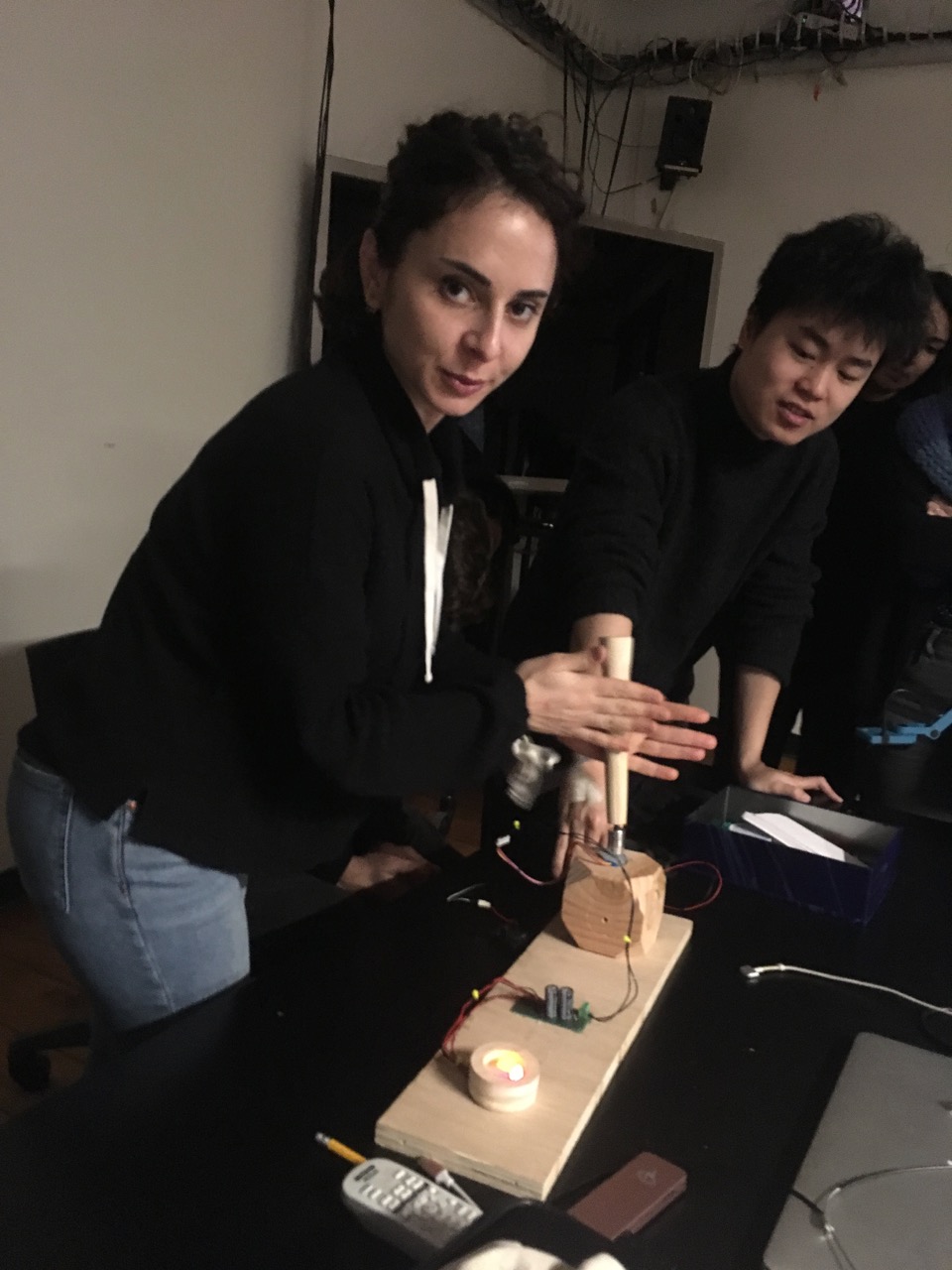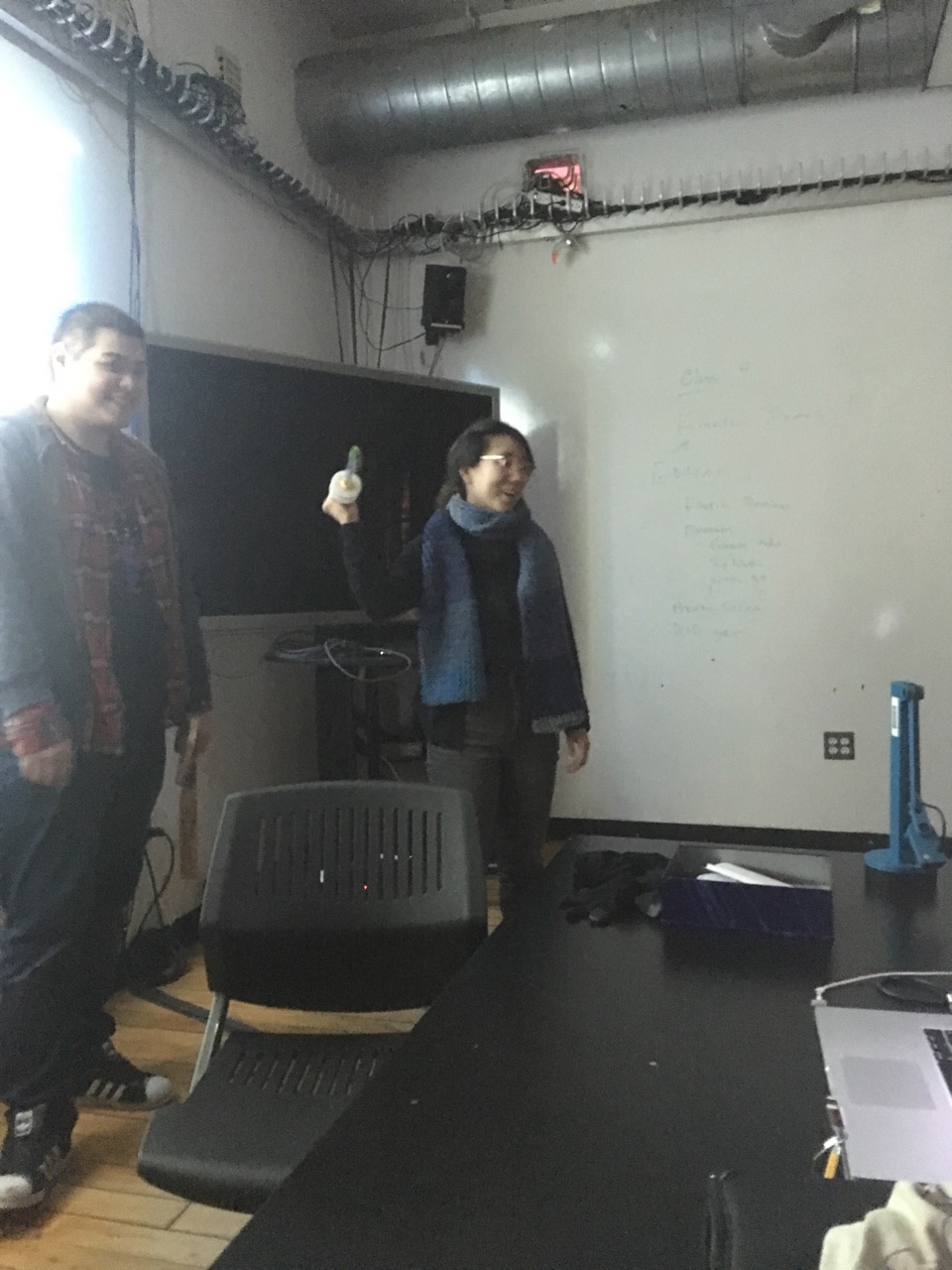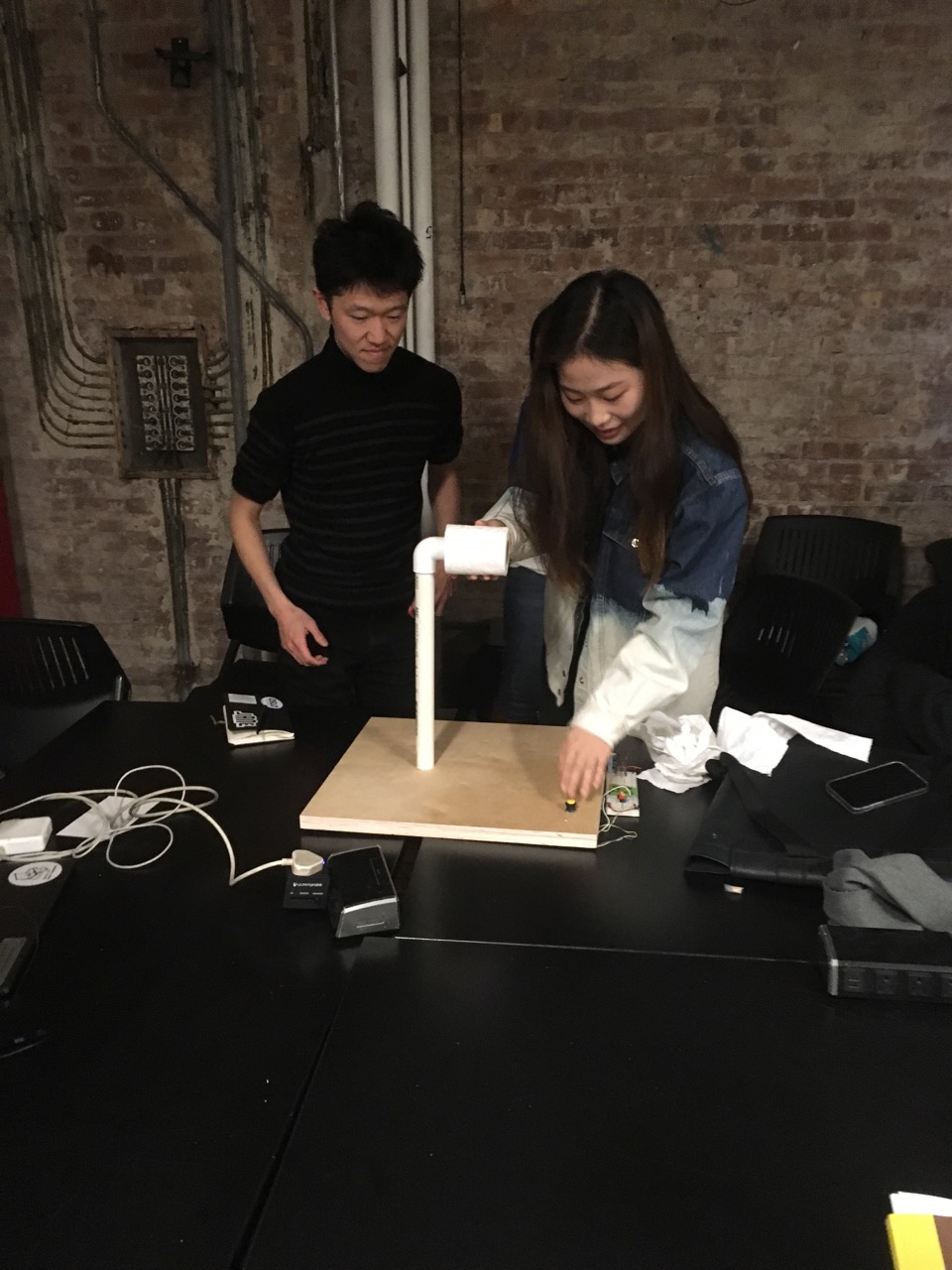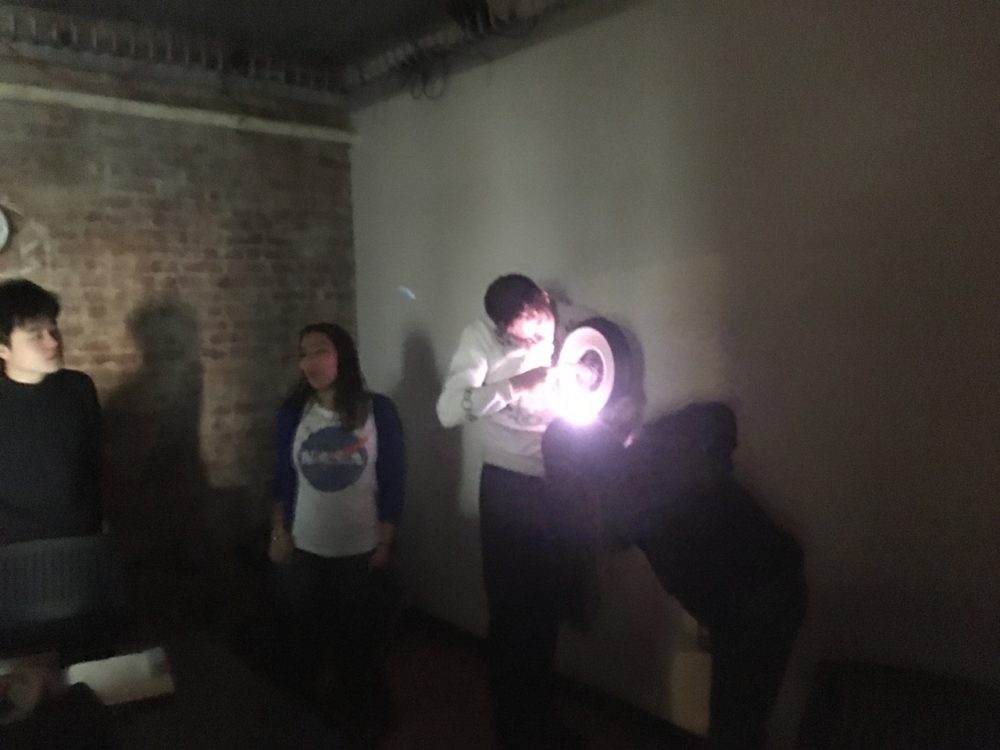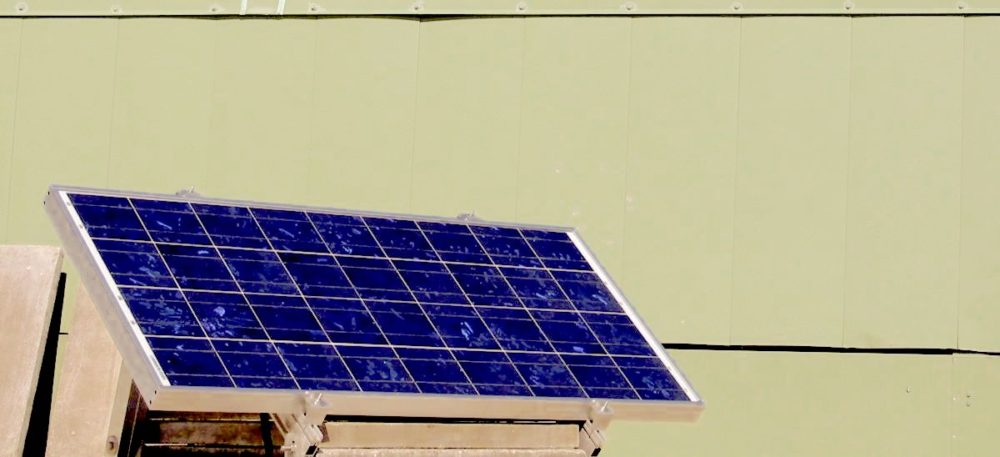
Thursdays, 12:10PM-2:40PM
Go to: Main class page goto week: 01 02 03 04 | 05 06 07 || 08 | 09 10 11 12 13 14 | Assignment briefs
Schedule Overview:
| Date | Class | Date | Class |
|---|---|---|---|
| 1/31 | 1. Intro, start kinetic projects | 3/28 | 8. Solar Demo Day, R&D team meetings. |
| 2/7 | 2. Generate I: Kinetic | 4/4 | 9. Special Topics |
| 2/14 | 3. Storage I: Capacitors | 4/11 | 10. R&D Groups 1 and 2 |
| 2/21 | 4. Kinetic presentations, start solar projects | 4/18 | 11. R&D Groups 3 and 4 |
| 2/28 | 5. Store II: Batteries | 4/25 | 12. Workshop |
| 3/7 | 6. Generate II: Solar A | 5/2 | 13. Special topics |
| 3/14 | 7. Generate II: Solar B and Solar hardware demo | 5/9 | 14: Final class |
| 3/21 | Spring break, no class! |
Student Documentation:
Your documentation links will go here.
Timothy Lobiak
Luming Hao
Emily Lin
Camille Weins
James Hoskin
Sukanya Aneja
Brent Baily
Xinyue Li
Rashida Kamal
Sid Chou
Defne Onen
Aileen Stanziola
Yunze Shi
Yuanyuan Wang
Some previous class work:
Last year's class blogs: Roland Arnoldt Yeseul Song Sam Chasan
Jason Young Dan Oved Dominick Chang Jenny Lim
Anita Mbabazi Fanni Fazakas Marcha M Johnson
Arnav Wagh Daniel Castano
Also check out the archive of past class projects.
Note: This year, there are lots of people on the floor to support the Energy class. The ITPower group includes students, Residents, and faculty, and will be meeting every other Thursday this semester to discuss energy issues at ITP. Among the Residents, Jenny Lim, Mithru Vigneshwara, and Yeseul Song took the Energy course, and Jasmine Soltani and Rushali Paratey are involved in ITPower. David Rios took the course a long time ago and holds the record for biggest magnet/coil wearable synthesizer.
1. Introduction
January 31
We meet each other and get a sense of the course and semester schedule.
Most of your projects at ITP have an on button and a power supply – they are active energy users. They might even never turn off. This is possible because computation has become extremely efficient, abundant, and cheap. At the same time, the work you create at ITP may help make technology more compelling and irresistible part of daily life. The energy consequences of that on button are magnified.
But if you’ve ever smelled that “hot electronics” smell from a frying transistor or voltage regulator, you’re closer than most to being able to tackling questions about energy directly. And because of your work at ITP, you are in a good position to understand energy in a precise and nuanced way – an understanding generally all too lacking.
In this first class we begin the adventure of looking at the world – from the scale of an individual electronics project to the scale of the universe – in terms of energy. We introduce (or reintroduce) some of the few terms and units we will rely on throughout the semester: watts, joules, work, power.
The first class serves as an introduction to some of the larger themes we will pursue over the course of the semester. We look at the origins of the course and the relevant parts of my background, and hear from you about your experience and expectations.
Agenda:
- Introductions
- Origin and purpose of the class
- semester overview
- Build, measure and modify pendulums
Assignments for next class:
- Flash an LED using a motor or magnet and coil. Bring this to class. The video below may be helpful.
- Review the syllabus, assignments, and video resources.
- Subscribe to Green Tech Media’s Energy Gang podcast; listen to their 2018 Year-in-Review episode.
- Order the Smil text.
- Setup your online documentation and send me the link.
2. Generate I : Induction
February 7
We quantify kinetic energy, and induce electrical currents by moving magnets.
Last week we used some basic physics like force = mass * acceleration to start to understand our SI units for energy (the joule = 1 newton * 1 meter) and power (1 watt = 1 joule / 1 second). We used this to calculate things like the difference in gravitational potential energy in the masses of our pendulums when they were raised to their starting points.
This week we’ll start with a very birds-eye view of energy, covering the history of the universe in a few minutes, up to “the world until yesterday”. We’ll see the genesis of heat engines – devices that turn chemical energy from fuel into useful mechanical work and which have fundamentally shaped the modern world; and we’ll introduce induction, the primary means by which we turn mechanical work into electricity. Almost every electron we use is pushed to us this way.
Agenda:
- Visit from ITP prof. David Rios and his Iron Man synth, a great kinetic project!
- Kinetic Energy Overview (slides)
- “5” Minute Energy (slides)
- Lab: Generating and Conditioning. Topics will include:
- Measuring current with a meter
- Measuring open circuit voltage, closed circuit current of a converter
- Intro to: Voltage regulators, bridge rectifiers, role of capacitors
Reading:
- Smil, Energy, a Beginner’s Guide Chapters 1 and
23 (we’ll go back to 2 during the solar assignment) - Energy Scavenging for Mobile and Wireless Electronics, Paradiso, Starner, 2005.
- Some good material on induction can be found in this recent Make project
- Check out Mathura G’s excellent kinetic project from ’16. (64 LEDs!)
Assignments for next class:
- Find capacitors for your kinetic project, and play around with charging and discharging them.
- Continue building your kinetic device. Using an oscilloscope and multimeter, measure or estimate the open circuit voltage and short circuit of your generator. How fast can you charge your capacitor?
These videos can fill in some electrical background useful at this stage: Rectification, Short Circuit Current (especially steppers), Energy Conversion and Conditioning
3. Store I : Capacitors
February 14 ♥
We quantify energy stored in capacitors.
An LED is a pretty forgiving load, since it doesn’t doesn’t need to boot up and compute anything. As long as we provide enough current (but not too much) we can light it up. So using an LED (or rather, light in general) for the kinetic challenge is a good place to start. However, we might eventually want to power a less forgiving load – something like a microcontroller that requires a more carefully regulated power supply.
To run a more complex load, or even just to manage the light better, there are various steps for conditioning and storing that electricity you might want to try. This week, will focus on capacitors, for two reasons. First of all, they have many uses in circuits, from storing energy to smoothing out voltage fluctuations and filtering signals (which can also be thought of as storing energy on very small time scales). Second, the energy they store is easily quantifiable with an equation – we can directly correlate the voltage a capacitor is charged to with an energy content in joules. We’ll also review rectification and look at ways to change DC voltage up or down.
The Paradiso/Starner reading gives a good introduction to the kinds of sources that might be considered for powering mobile electronics. (BTW – they’ve treated each topic covered in that paper in more depth elsewhere. Search for their papers if a particular area is of interest.) Typically those sources are low power and intermittent, both factors in requiring some degree of energy storage.
Agenda:
- Hear from ITPower
- Discuss GTM, Paradiso and Smil
- Energy Storage, Capacitors, Strategies for conditioning kinetic input.
- See kinetic challenge hardware in progress
- Lab: Estimating power by charging capacitors
Assignments for next class:
- Finish Kinetic Project
- Finalize research topic
These videos review the energy storage and conditioning material we see in class today: Energy Storage and Energy Conversion and Conditioning
4. Kinetic Demo Day
February 21
You show off your kinetic projects.
You’ve turned motion into light! One think I hope you’ll remember from the last few weeks is the feeling of turning a motor when it went from open circuit to shorted out. At that moment we started pulling current – capable of real, physical work – from our device, and there was an instant increase in the force needed to turn the crank. This is thermodynamics embodied, and related phenomena exist everywhere you look.
Also – your kinetic projects rocked! These blurry photos of a dark room prove it!

Defne, Yunze and James 
Emily, Sid, and Sukanya 
Xinyue, Camille, and Luming 
Yuanyuan and Brent 
Rashida, Aileen, and Timothy
The kinetic project is a model for almost all the ways we currently generate electricity. Wind, hydropower, coal, even nuclear energy or those solar “power towers” with the mirrors and the molten salt – they all eventually turn a generator and exploit induction to move current. (And all “feel” the same thing you did at a vastly larger scale: as electrical power demand fluctuates the forces needed to keep them moving change.)
The one big exception at grid scale is photovoltaics – the direct conversion of light into electricity. We turn our attention to that for the next project, powering computation with light.
Before we can begin solar in earnest, we first look at a second way to store electricity – electrochemical batteries. I’ve moved this up for two reasons – first, there are some confusing ways batteries are specified, making them hard to choose, so I hope to clear that up in week 5. Second, this in turn will allow you to BYO battery for the solar assignment (if you choose to use a battery). ITP has various types of solar panels you can use, but batteries will be up to you.
Agenda:
- See kinetic projects
- Kinetic debrief, Paradiso (again), negative work, Conan in a Prius.
- Depending on discussion/class interest: Big Kinetic, Kinetic Art, Energy Errors, Powers of 10.
Read:
- Smil Chapter 2
Assignments for next class:
- Record the specs for 3 batteries you use in your life: chemistry, voltage, and capacity (if capacity is in amp hours, can you get to watt hours?). Post these to your blog.
- Coordinate with your research topic fellows and discuss what aspects of your topic each person will focus on.
- Give some class feedback via this online form! Thanks!
This video digs into two battery-specific ratings, ‘amp-hours’ and ‘C-rate’ that might be a little confusing.
Links of the artists and projects discussed in class:
Kinetic art (and other cool stuff):
- Patrick Marold: http://www.patrickmarold.com/ solar and wind powered) Solar Drones, Windmill project
- Windswept, Charles Sowers https://vimeo.com/34887509
- Calder https://en.wikipedia.org/wiki/Alexander_Calder
- Jansen’s Strandbeast
- Jason Bruges Wind to Light (note Ali Express clone and car top lights, etc)
- Nature powered music https://derigo.me/en/blog/post/87/8-musical-sculptures-that-play-music-with-the-power-of-nature
- Aeolian harps (old!)
- Not art, but kinetic: hand-powered Malaria centrifuge and microfluidics lab!!
- Kinetic power! Humans are awesome!
- Sikorsky prize
- Human speed limit
- Gossamer Condor etc.
5. Store II: Batteries
February 28
An introduction to important characteristics of batteries.
I’ve visited Thomas Edison’s factory in East Orange, NJ, now a national park. On display are Edison’s library, large and precision machine shops, his early recording studio (where a variety of cones performed the function of microphones) and a reproduction of “Black Maria”, the house-like film stage with a retractable roof that could be rotated to follow the sun.
Edison developed a robust nickel-iron battery used in early electric transportation applications. Many of his other devices were powered by batteries in beautiful glass jars. Improvements in batteries since this time have been incremental – while the power density of batteries has increased (the ability to rapidly charge and discharge), their overall energy storage per unit of mass or volume has increased less rapidly.
In 2015 I wrote: “Some battery news this year (will any be around next year?) Sakti3, kAir (see also here), and packing peanuts.” Two years later, Sakti merged with Dyson, kAir pivoted and might have vanished, and there’s been no news since then on packing peanuts as batteries. This is typical of the battery space: each year brings promises of a new technology that will revolutionize batteries, but actual innovations that can make it to market and actually be manufactured at scale are few and far between.
Agenda:
- Discussion – Final points on kinetic, GTM topics, etc.
- Intro solar kits and GTFOS
- Battery overview
- Break
- Energy-aware and low-power design
- Measurement lab
Assignment:
- Pick a computation platform for your solar project and…
- …measure the power used when the platform running different operations. Post these measurements to your blog, as they will be the basis for an energy budget for your project.
- If you’re using a battery and don’t already have one, plan to order one by next week at the latest.
Reading
- Smil, Chapter 4
- Catch up / stay current on GTM
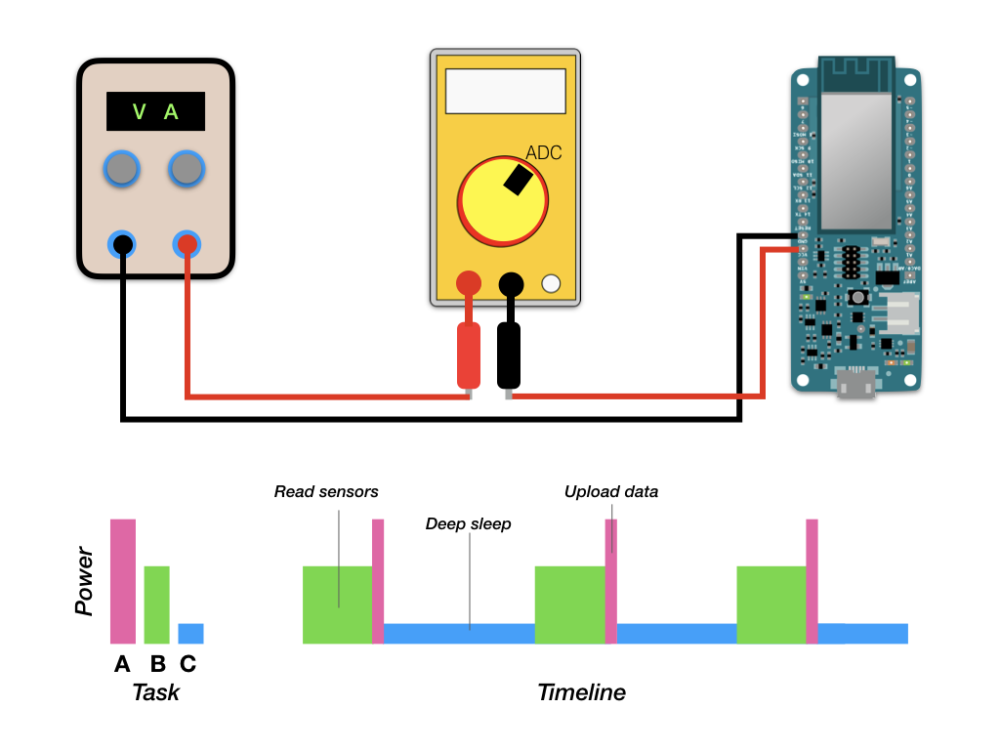
6. Generate IIA: Solar
March 7
We meet photovoltaic materials.
Aside from nuclear, tidal, and geothermal energy, all energy ultimately comes from our sun. In space, near earth, this power flow is about 1370W per square meter; on earth with the sun directly overhead we can expect about 1000W per square meter. This enormous power flow drives the wind and waves (the kinetic energy of which we can capture), lifts the water that rains down and fills damn reservoirs (the elevation of which provides gravitational potential energy), and, for billions of years, has been captured by life on earth, subsumed by geological forces and transmuted into the fossil fuels – coal, oil, natural gas – that are currently powering our civilization.
But as powerful and pervasive as sunlight is, compared to the fossil fuels we’ve become accustomed to, it is diffuse and intermittent: it will take a lot of PV material, and the ability to economically store the electricity it produces, to run big parts of civilization. In this class, we start small, looking at small portable devices and BEAM robots; these will serve as a basis for considering big solar power.
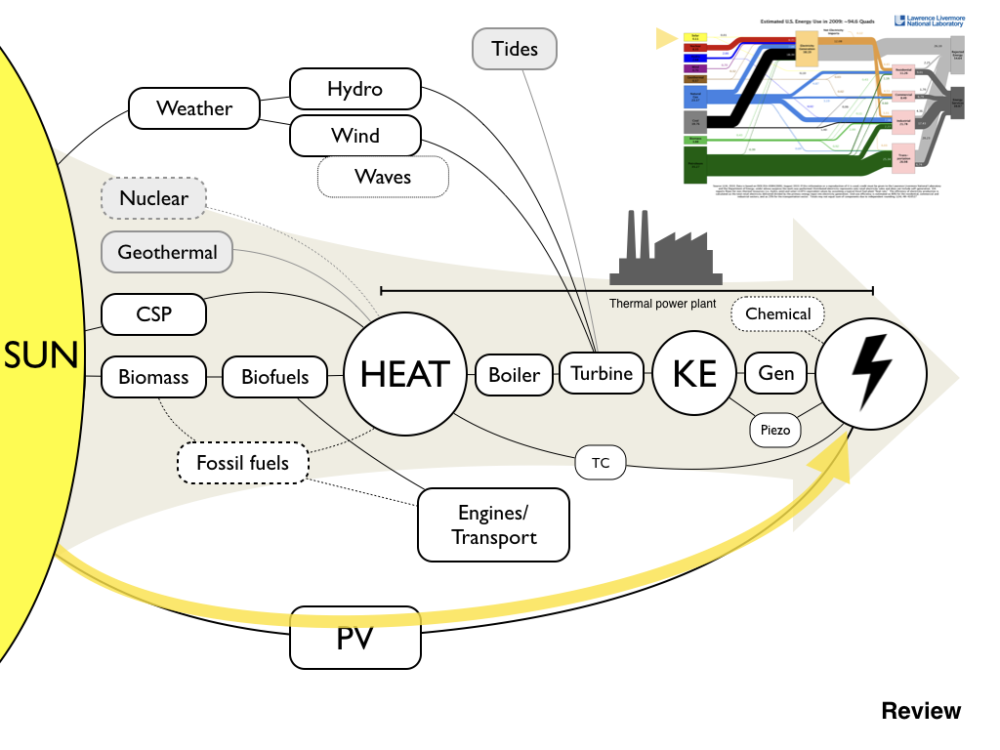
Agenda
- Review measurements
- Review hardware, especially charge controllers
- Why solar? Solar slides
- Break
- Workshop – PV SCC & OCV
- GTFOS first part unboxing
Reading
- Really catch up on Smil (through chapter 4)
- Catch up on GTM
For next class
- Continue developing your solar projects. Try to get your project living in sunlight for an extended period this week, and be prepared to discuss at next class.
- Continue your R&D research
- Consider final projects. We will have an initial discussion next week. Finals could extend the kinetic or solar projects; continue your research; support work in another class; or be a self-contained project that tackles energy.
7. Generate IIB: Solar Details
March 14
We learn additional details about PV and the balance of solar systems.
Photovoltaic materials are just the beginning of a chain of technologies that support solar energy. Today we’ll look at all of the “Balance of System” components that might go into a typical solar installation, such as inverters, charge controllers and module-level electronics. We’ll look at various schemes for tracking and concentrating light onto PV materials, advanced cell types, and some similar tech like concentrating solar power and solar thermal applications.
Agenda
- Solar Balance of System notes
- Hardware demo start
- Break
- Hardware demo continued
- Brainstorm finals
- Solar tracking, etc. notes
Assignment
- Finish Solar projects!!
- Finalize final concept, post brief description to blog
- Continue R&D
March 21: No Class – Spring break
8. Solar Project Demo Day
March 28
You show off your solar projects.
Agenda:
- Solar presentations
- R&D check in
- Discuss topics for next week
Presentations:
- Video Synth – Sukanya
- Thermie – Timothy and Sid
- UV Pen – Camille
- Cool Bunny – Emily
- Power Plant – Brent, Rashida, James
- 1-Bit – Luming and Aileen
- Sunrise Lamp – Xinyue and Yunze
- Wind walker – Defne
For next week:
- Find an electrical and/or gas bill from where you live now, or where you used to live (international a plus!)
9. Special Topics
April 4
Who knows? Big kinetic systems? The Carnot limit? The Fermi paradox and aestivation hypothesis?
Agenda
- Check in with R&D groups 3 and 4
- Look at energy we’ve paid for
- Discuss finals
- Solar 2 continued
- Energy orders of magnitude.
Assignment
- Continue working on R&D presentations and finals.
10. R&D Round I
April 11
Groups 1 and 2 present their research topics.
Embodied Energy / Recycling: Yunze, Yuanyuan, Sid
Decarbonization / Alternate Energy Sources: Brent, Aileen, Camille, Timothy
11. R&D Round II
April 18
Groups 3 and 4 present their research topics.
Art and Energy: Sukanya, Defne, Luming, Xinyue
Electrify Everything: Rashida, James, Emily
12. Workshop
April 25
We’ll meet as individuals or groups to workshop issues on final projects.
13. Special Topics
May 2
Dyson spheres and Type II civilizations? ITER vs Gen4 small modular reactors?
14. Finals
May 9
Yay!
